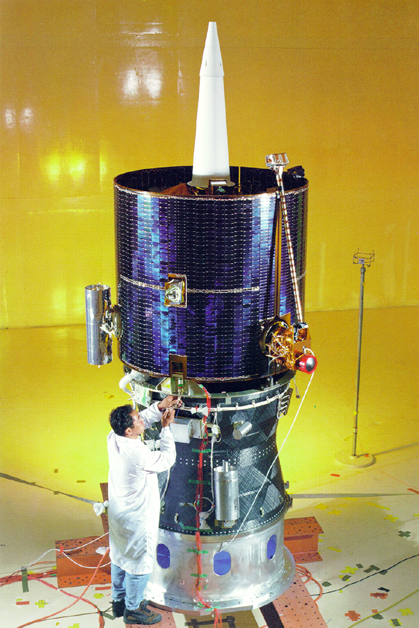Space History Photo: Lunar Prospector in Clean Room

In this historic photo from the U.S. space agency, the fully assembled Lunar Prospector spacecraft is shown in January 1997, mated atop the Star 37 Trans Lunar Injection module. Lunar Prospector represented the first NASA spacecraft to revisit the Moon in 25 years.
In December of 1972 Apollo 17 astronauts Gene Cernan and Harrison Schmitt were the last humans to set foot upon the Moon and the last NASA mission to visit the lunar frontier. On January 6, 1998 at 9:28 p.m., Lunar Prospector was launched from Cape Canaveral, Florida aboard a Lockheed Martin Athena II rocket.
Also onboard were the ash remains of astrogeologist Eugene M. Shoemaker. A scientist from the U.S. Geological Survey, he was detailed to NASA and helped train Apollo astronauts in lunar geology. However, as co- founder of a "rogue string" of comet fragments, his name will forever be linked to the much hearlded Shoemaker-Levy 9 cometary impact of the planet Jupiter in 1995.
Lunar Prospector mapped the Moon's elemental composition, gravity fields, magnetic fields and resources. Prospector provided insights into the origin and evolution of the Moon. One of the most significant finds by Lunar Prospector was confirmation that there could be as much as 10 billion tons of subsurface frozen water near the Moon's polar region.
The Lunar Prospector mission came to a creative and daring conclusion when on July 31, 1999 at 2:52:00.8 a.m. PDT Mission Control Ames directed the spacecraft to a crash landing into a deep crater near the Moon's South pole. The hope was that the impact might release trapped water vapor. However no visible debris plume was detected by numerous observatories monitoring the event. This lack of direct evidence has not diminished the hope or belief that subsurface frozen water does exist.
Each weekday, SPACE.com looks back at the history of spaceflight through photos (archive).
Breaking space news, the latest updates on rocket launches, skywatching events and more!

The National Aeronautics and Space Administration (NASA) is the U.S. government agency in charge of the civilian space program as well as aeronautics and aerospace research. Founded in 1958, NASA is a civilian space agency aimed at exploring the universe with space telescopes, satellites, robotic spacecraft, astronauts and more. The space agency has 10 major centers based across the U.S. and launches robotic and crewed missions from the Kennedy Space Center in Cape Canaveral Florida. Its astronaut corps is based at the Johnson Space Center in Houston. To follow NASA's latest mission, follow the space agency on Twitter or any other social channel, visit: nasa.gov.
